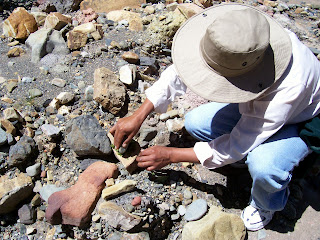Elecampane Inula Helenium (Linnaeus) from Azurae's garden
Family: N.O. Compositae
It's great for coughs, bronchitis. Stimulates digestion and appetite.
Cough recipe: Make a drink by infusing Elecampane roots with sugar and currants in white port.
Preserve with sugar or honey, make into a syrup to warm a cold (gassy) stomach or relieve stitches in the side.
You can also make lozenges to suck on. An old-time favorite remedy said to relieve coughs, tuberculosis, asthmas and bronchitis.
Astringent: The distilled water of the leaves and roots rubbed on the skin removes lesions, blisters, spots or blemishes.
The root was eaten to help digestion and "cause mirth."
The root can be candied and eaten as a sweet.
Chewing the root was considered benefitial to 'fasten the teeth.'
Galen maintained that 'It is good for passions of the hucklebone called sciatica.' The hucklebone refers to ankle or hipbone.
 |
Elecampane
stalks and leaves |
Habitat: It is found wild throughout continental Europe, extends eastwards in temperate Asia as far as Southern Siberia and North-West India. In North America, it has become thoroughly naturalized in the eastern United States, from Nova Scotia to Northern Carolina,
westward as far as Missouri. It grows abundantly in pastures, along roadsides. It grows well in moist, shady positions, in ordinary garden soil, especially at or near the base of eastern and southern mountain slopes.
It grows up to 4 or 5 feet high, is very stout and deeply furrowed, and near the top, branched. The whole plant is downy.
It produces a radical rosette of enormous, ovate, pointed leaves, from 1 to 1 1/2 feet long and 4 inches broad in the middle,
velvety underneath, with toothed margins an borne on long foot-stalks.
 |
| Elecampane flowers and leaves |
The plant is in bloom from June to August. The flowers resemble a double sunflower but not as large.
Flowers are bright yellow, in very large, terminal heads, 3 to 4 inches in diameter, on long stalks. The broad bracts of the leafy involucre under the head are velvety.
After the flowers have fallen, these involucral scales spread horizontally. Removal of the fruit shows the beautifully regular arrangement of the little pits on the receptacle. The fruit is quadrangular and crowned by a ring of pale-reddish hairs - the pappus.
 |
| Elecampane root |
Cultivation: Seeds may be sown, either when ripe, in cold frames, or in spring in the garden. It is best propagated by off-sets, taken in the autumn from the old root, each with a bud or eye.
These will root readily. Plant in rows about a foot wide with 9-10 inches between the rows. Cut the root into pieces about 2 inches long, covering with rich, light, sandy soil. Overwinter in light heat.
The plant grows from a perennial rootstock. The root is taken from plants two to three years old, dug up in the fall. Older plants become woody.
The drug sold as Elecampane (Radix Inulae), consists of both rhizome or rootstock and roots.
Used as an expectorant, relieves coughing. Creates antimicrobial activity in the mouth and throat.
The bitterness stimulates the secretion of gastric juice and bile.




















